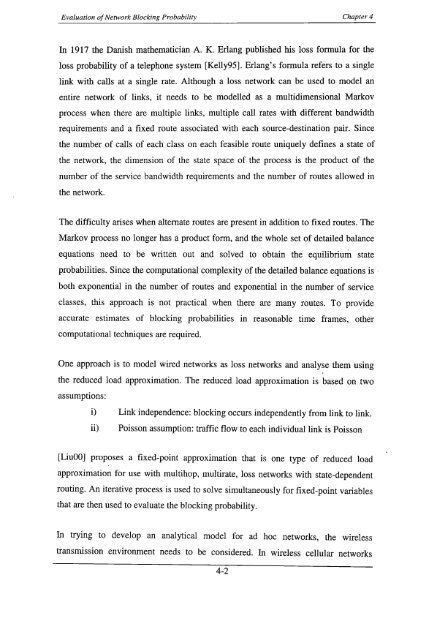Gugrajah_Yuvaan_ Ramesh_2003.pdf
Gugrajah_Yuvaan_ Ramesh_2003.pdf
Gugrajah_Yuvaan_ Ramesh_2003.pdf
Create successful ePaper yourself
Turn your PDF publications into a flip-book with our unique Google optimized e-Paper software.
EvaLuation ofNetwork Blocking ProbabiLity Chapter 4<br />
In 1917 the Danish mathematician A. K. Erlang published his loss formula for the<br />
loss probability of a telephone system [Kelly95]. Erlang's formula refers to a single<br />
link with calls at a single rate. Although a loss network can be used to model an<br />
entire network of links, it needs to be modelled as a multidimensional Markov<br />
process when there are multiple links, multiple call rates with different bandwidth<br />
requirements and a fixed route associated with each source-destination pair. Since<br />
the number of calls of each class on each feasible route uniquely defines a state of<br />
the network, the dimension of the state space of the process is the product of the<br />
number of the service bandwidth requirements and the number of routes allowed in<br />
the network.<br />
The difficulty arises when alternate routes are present in addition to fixed routes. The<br />
Markov process no longer has a product form, and the whole set of detailed balance<br />
equations need to be written out and solved to obtain the equilibrium state<br />
probabilities. Since the computational complexity of the detailed balance equations is .<br />
both exponential in the number of routes and exponential in the number of service<br />
classes, this approach is not practical when there are many routes. To provide<br />
accurate estimates of blocking probabilities in reasonable time frames, other<br />
computational techniques are required.<br />
One approach is to model wired networks as loss networks and analyse them using<br />
the reduced load approximation. The reduced load approximation is based on two<br />
assumptions:<br />
i) Link independence: blocking occurs independently from link to link.<br />
ii) Poisson assumption: traffic flow to each individual link is Poisson<br />
[LiuOO] proposes a fixed-point approximation that is one type of reduced load<br />
approximation for use with multihop, multirate, loss networks with state-dependent<br />
routing. An iterative process is used to solve simultaneously for fixed-point variables<br />
that are then used to evaluate the blocking probability.<br />
In trying to develop an analytical model for ad hoc networks, the wireless<br />
transmission environment needs to be considered. In wireless cellular networks<br />
4-2
















